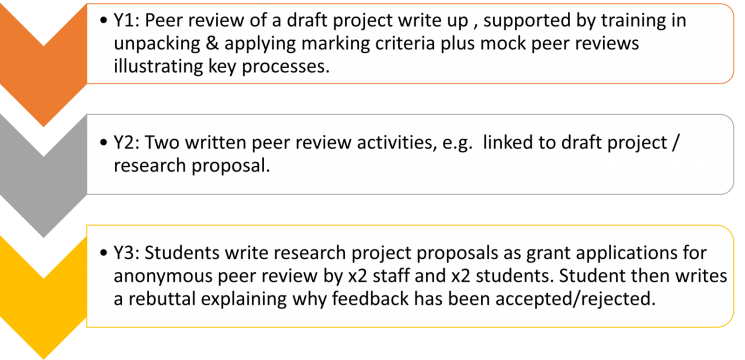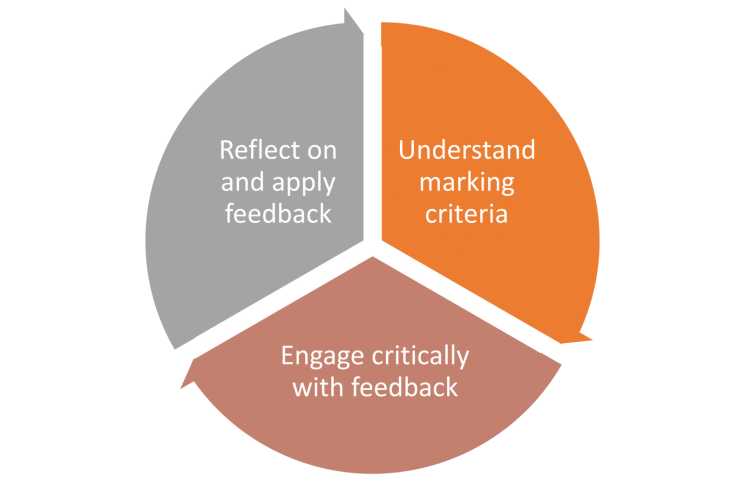Understand curriculum design principles and strategies to help students master feedback literacy skills, and approaches.
What is feedback literacy?
Feedback literacy is defined as “the understandings, capacities and dispositions needed to make sense of information and use it to enhance work or learning strategies” (Carless and Boud, 2018).
In other words, feedback literate people are not simply passive recipients of feedback. Rather, they:
- appreciate feedback as an active and reciprocal process, of which they are part
- recognise the role of feedback in their continuous improvement
- are active in seeking out and engaging with feedback from others
- are open to critique and are sensitive and constructive in offering feedback to others
- have the skills to interpret and act on the feedback they receive.
These are lifelong skills, as valuable in the workplace as they are in the classroom.
Why focus on feedback literacy?
This is a learning- centred approach to feedback which focuses attention on the actions of students rather than, primarily, as an act of teachers.
Developing students’ feedback literacy can help them:
- become engaged, proactive and independent learners
- build the emotional and intellectual confidence to seek out, and engage in dialogues about their subjects
- recognise the skills they are developing through their studies
- develop their understanding of, and critical engagement with, their subjects
- feel seen, heard and supported through their learning journey because they recognise how the feedback they have received has helped them to learn and develop.
For academics, a focus on improving student feedback literacy can contribute towards:
- constructive reflection on teaching and assessment design (formative and summative)
- improved student experience metrics.
Curriculum design principles for embedding feedback literacy
Developing students’ feedback literacy is a cumulative and iterative process. In other words, there’s little point giving students a study skills module in year 1 and expecting it to carry them through to graduation and beyond.
Applying the principles below will help to embed strategies to develop students’ feedback literacy. These principles need not supersede, and should complement, other principles of curriculum design. They include working to:
- foster a culture that promotes constructive dialogue about marks and feedback (staff and students as partners)
- consider how your curriculum design and communication can open up opportunities for students to apply, and potentially further reflect on, the feedback they receive
- consider how your assessment design opens up or closes down opportunities for developing relevant skills; make the most of opportunities to embed assessment for learning principles, which require students to reflect on their learning and identify opportunities for improvement, such as authentic assessments
- exploit the learning potential of feedback such as designing in opportunities for feed forward
- provide students with many, and different, opportunities to practice giving, receiving, interpreting and acting on feedback (see below)
- develop students’ skills over time; don’t make your students run before they can walk. Educate students with techniques to self-review their work as well as work of their peers in a systematic way. Scaffold the process of using feedback, just as you would do for students’ critical thinking skills. For instance, step one may be to introduce first year students to HE subject expectations.
Below is an example of a course design and how feedback literacy can be embedded in a programme.
- A course design example
The figure below describes one approach to scaffolding the principles for embedding feedback literacy into an ecology undergraduate programme at the University of Otago (described in Malecka et al 2020). Note how this approach also applies authentic assessment principles.

Curriculum design practices
Whether developing a module or a whole curriculum, consider the following approaches to developing your students’ feedback literacy.

- Understand marking criteria and engage critically with feedback
By understanding the role of criteria and rubrics, students will be able to engage critically with feedback. Create opportunities for your students to:
- familiarise themselves with the marking criteria and understand the language used
- analyse exemplars and apply marking criteria/rubrics
- engage in peer review (individually or in groups), such as of fellow student drafts or submissions, or a paper from an academic journal
- undertake peer assessment
- engage in self-assessment, for instance, by requiring students to assess their own work against the given assessment criteria (which they might submit as a cover sheet with their assignment) or contributions to a group project
- co-construct and apply marking rubrics. See examples in Flexible Assessment.
- Reflect on and apply feedback
Create opportunities for your students to:
- discuss how insights from analysing the work of others (such as exemplars or being asked to provide feedback to their peers) have changed how they approach their own work
- submit assignment cover sheets, identifying areas they were least confident in/would like feedback on, or aspects they have tried to improve based on previous feedback. Provide pro-formas or prompts
- reflect on how they applied feedback on drafts, such as by including a reflective piece as part of the portfolio of assessment task. It could be useful to provide prompts to support this reflection.
How can learning technology help you?
Learning technology can help you in a number of ways, such as:
- posting project ideas and sharing peer feedback using asynchrous discussions in Canvas
- utillizing the Canvas peer assessment tool
- using Applications like RM Compare to engage students in making productive evaluative judgments (and, maybe, reducing marking loads for staff).
References and further reading
Find further information from:
Boud, D. & Dawson, P. (2021) What feedback literate teachers do: an empirically-derived competency framework, Assessment & Evaluation in Higher Education.
Carless, D. & Boud, D. (2018) The development of student feedback literacy: enabling uptake of feedback, Assessment & Evaluation in Higher Education, 43:8, 1315-1325,
Pitt, E. (2020) Towards the development of student feedback literacy: somewhere for feedback to land. In Baughan, P. (ed) On Your Marks: Learner-focused Feedback Practices and Feedback Literacy. Advance HE.
